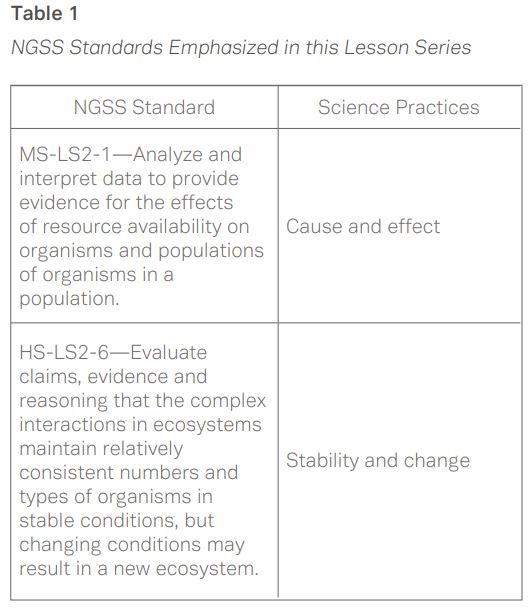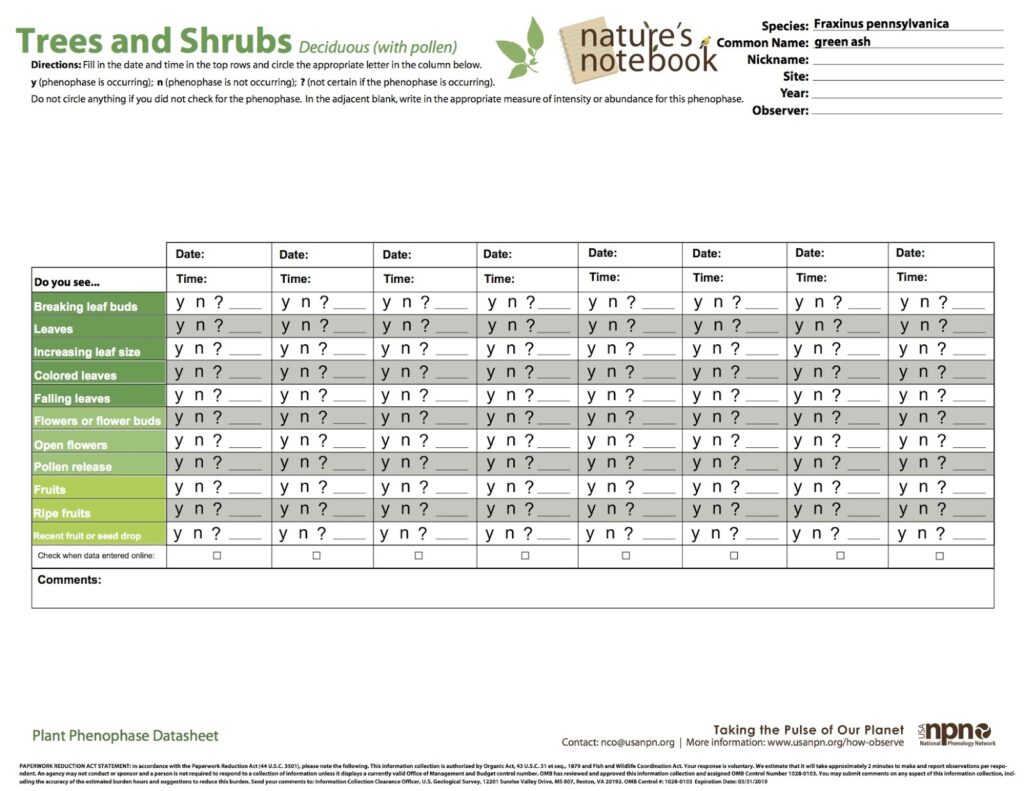Advancements in technology have transformed the methods students use to learn about the natural world; answers are often at our fingertips with a simple Google search. As a result, young people need to develop the skills to navigate an information-rich society alongside their scientific practices as described in the Next Generation Science Standards (NGSS). Our students’ technology-based culture, methods of communication and recreation, and ways of knowing are changing as well. The ways in which society engages with nature and technology will have profound impacts on our future. Taking time to slow down to find the pulse of our planet through observations in nature requires both technological literacy and a curious mind, both essential for the future of scientific practice and discovery. In order to challenge the ways my students critically think about information, I created a year-long citizen science learning experience for students to collect authentic data from nature observations. This turned into a powerful tool for marrying technology and nature in the classroom setting.
Citizen science is the collection and recording of data by the general public and includes a variety of projects and visualization tools that are accessible through various websites or apps. This data is often used for the benefit of researchers, other educators, resource managers, and important decision makers in conservation. These platforms also provide students at increasingly younger ages the opportunity to work with large quantities of data. In my classroom, our year-spanning guided inquiry connected students to nature, empowered them as scientists, provided new perspectives on environmental indicators of climate change, and developed skills that would reach beyond the classroom.
Planning to Connect Students to Nature Through Inquiry and Technology
When I asked my rural, Midwestern seventh-grade students about their sunshine-filled weekends, I was surprised that many would explain they spent their time indoors playing video games, watching Netflix, or engaging with other technology. My students seemed to be missing out on those vivid nature-based experiences I reflect on so fondly as an adult. This could have consequences for the conservation of our planet, as many environmental studies suggest that nature connection is a fundamental building block for creating future environmental stewards (Louv, 2005). I wanted to help my students develop an appreciation for the outdoors.
To develop this appreciation, my students needed to learn how to take their time noticing elements of nature. Facilitating nature connection would be more powerful if students could integrate the key NGSS science inquiry practices, such as: asking questions and defining problems; analyzing and interpreting data; and obtaining, evaluating, and communicating information. Through these considerations, I developed a lesson that can be modified to meet both middle- and high-school NGSS standards (see Table 1).

Finally, I saw an opportunity to connect this experience to our real-world understanding of climate change. Phenology, the study of repeating yearly events observed in living things, is an excellent context for teaching climate change. This is due to the students’ ability to observe and make data contributions, just as professional and citizen scientists do, to databases that help us track environmental impacts of global climate change. As temperate forest trees have dealt with changing seasons for millennia, tree species have evolved their cued seasonal responses differently. Responses include temperature, sunlight exposure or a combination of both. These responses are especially important with the onset of rapidly shifting carbon dioxide levels and resulting temperature change. As temperature changes occur, the specific observable seasonal events or phenophases, such as autumn leaf color change or spring budding, will respond by adjusting their timing. Many of my students struggled to fully comprehend climate change prior to this lesson, and participating in this nature-based citizen science data collection was a great way for them to think more deeply about evidence and the earth as an interacting system of cause and effect.
To support these goals and connect students to nature using technology, I chose Nature’s Notebook (USA National Phenology Network, n.d.-a). Created by the USA National Phenology Network, Nature’s Notebook is a free website and application that specializes in tracking phenophases in plants and animals. The opportunity to evaluate large phenology datasets through a visualization tool, while learning to understand the data collection process, helps my students draw conclusions about seasonal trends over time.
I hunted my school grounds and chose a green ash tree (Fraxinus pennsylvanica) on campus for its easy accessibility for ongoing student observations. After creating an observation deck on Nature’s Notebook, I downloaded a species profile on the green ash tree which provided general background, phenophase definitions, and a data collection sheet (USA National Phenology Network, n.d.-b) (see Figure 1). Starting in the fall season and extending into spring, some of the specific phenophases observed and recorded by my students on the data collection sheet were colored leaves, falling leaves, breaking leaf buds, and pollen release.

Figure 1. Green Ash Tree Data Collection Sheet Developed by the USA National Phenology Network. Note. This figure shows an example of a free, downloadable phenology protocol developed by the USA National Phenology Network. This example is a free downloadable phenology green ash datasheet from Nature’s Notebook (USA National Phenology Network, n.d.-b) with accompanying phenophases extending through the year.
I also located a grove of trees and bushes of various species at my school. This location became the place where students would select their “nature nook” (McGowan et al., 2010), a sit spot where students would return throughout the year to deepen their exposure to natural settings and develop their observation skills.
Nature Nook Books
To kick off my yearlong, nature-based citizen science project, I started with an observation activity in the fall. I wanted to engage and introduce my students to observing aspects of nature with a nature nook book (see Figure 2).

Figure 2. Student Nature Nook Book with Student Drawing.
After we arrived at the grove, I asked my students to use their nature nook book to record their questions about the plants they saw in their nature nook. We revisited their nature nooks multiple times throughout the year. For this first observation, I encouraged students to share their questions with peers, which ultimately allowed me to introduce the terms phenology and phenophase.
After students shared their initial observations, I introduced the importance of citizen science and how they would be serving as scientists. My students began up-close observations of our green ash tree, which continued throughout the year. Each time we visited the tree, we took an additional 20 minutes to visit their nature nook to hunt for other examples of phenophases.
After our time outdoors, we returned to the classroom and submitted our green ash tree data to Nature’s Notebook. Students honed in their observation skills by taking a total of eight different observations throughout the school year.
Guided Inquiry
To scaffold and model the inquiry process for my students, our guided inquiry took place after the class completed their final spring observations and focused on manipulating our green ash data, as well as green ash data from across the United States, using the online Nature’s Notebook visualization tool. Data were provided by the USA National Phenology Network and the many participants who contribute to its Nature’s Notebook program. We focused specifically on the spring phenophase “breaking leaf buds” because students had recently observed it and it is a strong indicator of spring timing and climate change.
To support students in navigating the visualization tool, I created a video with directions on how to generate budburst data on the green ash tree from 2014 to 2019. We discussed the fact that climate refers to an extended period of time, and that this five-year period represented a relatively small snapshot. I added a new template to my students’ nature nook book that aided them in plotting data and identifying trends in the green ash’s spring phenophase (see Figure 3).

Figure 3. Nature Nook Book Data Collection Template. Note. This figure shows a sample of student work. Students viewed the online visualization tool and transferred colored hash mark data from 2014 to 2019 to their template in order to identify trends in spring phenophases.
After plotting the data, students analyzed, interpreted, and searched for trends in the spring phenophases from year to year. Students were asked to contemplate a series of questions:
- Are the timing of seasonal changes the same each year? Why or why not?
- What changes in phenophase timing can you identify from year to year in your data?
- How would you predict the following year’s data to look, based on your current data?
During the class discussion that followed, students shared their reasoning for the observed shifts in the spring phenophases. Students concluded that the planet’s driving force for many seasonal changes was based on climate and that the trees were responding to those changes. This was an exciting moment as I watched my students discover climate change and understand it in a unique way.
Concluding Thoughts
The Nature’s Notebook platform served as the method for not only engaging my students in nature, but also bringing important evidence-based conversations on climate change, using real world datasets, into the classroom. What I found most rewarding, beyond the simple excitement my students had for being outdoors, was students’ responses when I asked if I should repeat this lesson with future students. They responded without hesitation, explaining that I should, and they began to share what they had learned from this work. I was delighted to hear several students chime in that timing is “the Earth’s way of sending messages” and describing their realization that “climate change was happening in [their] backyard.” Nature’s Notebook was not just a method of guiding my students through inquiry, but also set the foundation for promoting self-efficacy in full inquiry in the future. I began to understand phenology as a tool for making both seasonal and climate change tangible.
Climate is not the only thing changing that’s important in education. The work of adapting Nature’s Notebook tools and datasets for my students changed me as well. When teachers are allowed to pursue their passions and curiosity alongside resources for professional learning, the simplest idea can evolve to create something new.
Beth Keskey is a life science and Earth science teacher at Dassel-Cokato Middle School, located in Cokato, Minnesota. She currently engages with Project Dragonfly, an educational reform initiative through the Global Field Program at Miami University in Oxford, Ohio. As a graduate student pursuing a Master of Arts in biology, Beth focuses on biology education, multimedia, and community partnerships across the globe and United States. Tenets underlying her work include inquiry, voice, and community-based conservation. Reach Beth at bakeskey.bk@gmail.com.





